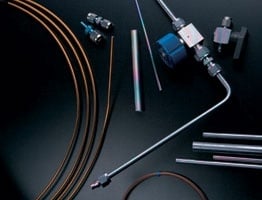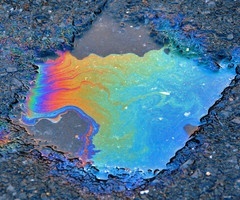
SilcoTek CVD coatings are known for making parts colorful. Do we do it on purpose just for the effect? And why don't you make coiled tubing colorful? Tubing is boring brown while other parts are ravishing rainbow. Why? Let's talk coatings and color...
Why Are SilcoTek CVD Coatings So Colorful
The basics, what is color? (I know this sounds like eye gouging 7th grade science. But bear with me...)
Color is a perceived "effect" of light absorption or light refraction. We humans have defined color but we can only see light in a limited spectrum from between 390 and 700nm. That's because our eyes come equipped with 3 cones that respond to 3 different types of light spectra. Short wavelength light (420-440 nm) is seen as blue, 534-545 nm is seen as green and long spectrum light, 564-580 nm, is seen as red. So we're set up on the RGB spectrum, just like TV! But not all animals have the same ability to see color. Some animal eyes are equipped with more cones, others have less. So don't expect your dog fluffy or that honeybee to see the same colors you do. Sadly they can't enjoy The Bachelorette with the same intensity as we can (OK that was sarcasm, stick with me here...). With that boring commentary out of the way, and we're all understanding what and why we're seeing, just exactly how are our coatings making so many colors?

SilcoTek coatings do not contain pigments (like paint). Pigments get their color because they absorb most of the white light and reflect back only the color you see. In fact our coatings are made primarily of silicon which in natural form looks like a gray shiny rock. So how does a gray rock become a shiny rainbow? It all has to do with super thin coatings and light refraction or bending.
The CVD coating process and how it makes color.
We bond silicon to metals, glass, or ceramics through a process called chemical vapor deposition (CVD). This process allows us to build a silicon layer on a surface one Angstrom (0.1 nanometer) at a time. A super thin layer of silicon is pretty clear, in fact you can see through a thin silicon layer. As the silicon thickness increases on say a stainless steel surface, light which travels through the silicon is bent. The light then reflects off the stainless surface and is bent again. All this light bending causes some wavelengths of light to cancel out each other while other wavelengths are reinforced. The canceled (or interference) wavelengths aren't seen by your eye while the reinforced wavelengths hit your cones and are seen as color. Changing the color of a thin silicon surface is easy, a few nanometer change in silicon thickness can have a big impact on the colors you see.
 The best analogy of this effect that I can relate to is oil on water. I'm sure you've noticed that after a rain storm a colorful rainbow oil slick can be found flowing from under that 1966 Mustang that's been parked in your driveway and waiting to be restored for the past 8 years. I know you'll get to it.... Anyway, oil is not colorful, it's either honey colored when new or black when draining from your oil pan. That black oil is becoming a colorful rainbow because of refraction. Light reflects off the top of the oil surface and also travels through the thin oil and is reflected back from the water surface below the oil. Depending on the thickness of the oil, light rays will either be reinforced or interfered with by the oil refraction. When the rays of light reach your eye, the destructive interference wavelengths cancel each other out. The oil thickness variation dictates what colors you see and what color wavelengths get canceled out. So a slight variation in thickness can have a big impact on the color you see.
The best analogy of this effect that I can relate to is oil on water. I'm sure you've noticed that after a rain storm a colorful rainbow oil slick can be found flowing from under that 1966 Mustang that's been parked in your driveway and waiting to be restored for the past 8 years. I know you'll get to it.... Anyway, oil is not colorful, it's either honey colored when new or black when draining from your oil pan. That black oil is becoming a colorful rainbow because of refraction. Light reflects off the top of the oil surface and also travels through the thin oil and is reflected back from the water surface below the oil. Depending on the thickness of the oil, light rays will either be reinforced or interfered with by the oil refraction. When the rays of light reach your eye, the destructive interference wavelengths cancel each other out. The oil thickness variation dictates what colors you see and what color wavelengths get canceled out. So a slight variation in thickness can have a big impact on the color you see.
The same holds true with silicon. Small variations in thickness can make a big difference in the color of the coating. So the different colors observed on Silco'd treated parts indicate different layer thicknesses. A blue color corresponds to a 300 to 450 Angstrom layer while a rainbow color indicates a coating of at least 1200 Angstroms (120 nanometers).
Colors associated with layer thickness are:

Depositions used in our Silcolloy® and SilcoGuard® processes are up to 1µm (1000nm) and have a rainbow to silver/metallic gray appearance. The photos below show colors created by SilcoNert®, a 500nm** coating (left) and Silcolloy®, an 800nm** coating (right). So as you can see, a few nanometers change in thickness will result in a dramatic change in the color of the part.

Problem solved! Our coatings are colorful because they're thin. Why do we make the coating thin? Because the amorphous silicon coating when thin does not impact part tolerance significantly and because our coatings are highly durable so they don't need to be thick.
Have other questions? Try our Frequently Asked Questions page.

So why don't we make parts all the same color? We're an industrial coating company so we're focused on the ultimate performance of the coating, not appearance. We could in theory make parts with uniform color, but that would impact coating thickness and may result in a less robust coating. Plus rainbow is more fun!
What about SilcoTek tubing?
 OK I understand why your fittings and valves are so colorful. But what about tubing? Why is the outside of my SilcoTek coated coiled tubing brown?
OK I understand why your fittings and valves are so colorful. But what about tubing? Why is the outside of my SilcoTek coated coiled tubing brown?
Well that's an easy one to answer. The outside of coiled tubing is not coated! Yep you heard it right. We coat the inside wetted surface of coiled tubing but not the outside. It's not really necessary to coat the outside and would add unnecessary cost to the tube so why not ditch the outside coating? The tube is brown because we heat the tube during the CVD coating process. The heated stainless steel surface oxidizes slightly, causing the SilcoTek lined tubing to turn brown. You've probably experienced the same effect if you've ever put a stainless steel pan on the stove and got distracted and left the pan on the hot stove for too long.
OK why are short tubes rainbow? Well for shorter length tubes and straight tubes (less than 2 meters long) we'll coat both the inside and outside of the tube surface. That's because it's less costly (and less expensive for the customer) to coat the inside and outside of small tubes.
Finally, from the "did you know file", or the "totally useless fact to throw out at a cocktail party file":
While doing some research for this piece and catching up on my 7th grade science, I came across an interesting factoid in the November 25-26th Wall Street Journal. The Everyday Physics column by Helen Czerski discussed the science of color in Blue Jays and Cardinals. It turns out that male Cardinals get their bright red color from the carotenoid pigment in the seeds and plants they eat. Imagine if we could change color based on our diet. What color would you be? I'd probably be red like the Cardinal, only more the shade of ketchup.
*Image credit: https://www.pinterest.com/explore/oil-spill/
*Note; coating thickness is approximate. Contact a Technical Service Representative to discuss specific coating thicknesses.







